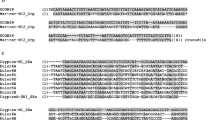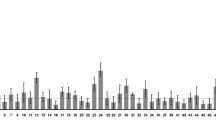Abstract
Alu elements are not distributed homogeneously throughout the human genome: old elements are preferentially found in the GC-rich parts of the genome, while young Alus are more often found in the GC-poor parts of the genome. The process giving rise to this differential distribution remains poorly understood. Here we investigate whether this pattern could be due to a preferential degradation of Alu elements integrated in GC-poor regions by small indel mutations. We aligned 5.1 Mb of human and chimpanzee sequences and examined whether the rate of insertion and deletion inside Alu elements differed according to the base composition surrounding them. We found that Alu elements are not preferentially degraded in GC-poor regions by indel events. We also looked at whether very young L1 elements show the same change in distribution compared to older ones. This analysis indicated that L1 elements also show a shift in their distribution, although we could not assess it as precisely as for Alu elements. We propose that the differential distribution of Alu elements is likely to be due to a change in their pattern of insertion or their probability of fixation through evolutionary time.


Similar content being viewed by others
References
PF Arndt DA Petrov T Hwa (2003) ArticleTitleDistinct changes of genomic biases in nucleotide substitution at the time of mammalian radiation Mol Biol Evol 20 1887–1896 Occurrence Handle1:CAS:528:DC%2BD3sXpt1Kgtrs%3D Occurrence Handle12885958
D Ayares D Ganea L Chekuri CR Campbell R Kucherlapati (1987) ArticleTitleRepair of single-stranded DNA nicks, gaps, and loops in mammalian cells Mol Cell Biol 7 1656–1662 Occurrence Handle1:CAS:528:DyaL2sXktVCrtL4%3D Occurrence Handle3474515
MA Batzer PL Deininger U Hellmann-Blumberg J Jurka D Labuda CM Rubin CW Schmid E Zietkiewicz E Zuckerlandl (1996) ArticleTitleStandardized nomenclature for Alu repeats J Mol Evol 42 3–6 Occurrence Handle10.1007/BF00163204 Occurrence Handle1:CAS:528:DyaK28XntFOntA%3D%3D Occurrence Handle8576960
EM Belle A Eyre-Walker (2002) ArticleTitleA test of whether selection maintains isochores using sites polymorphic for Alu and L1 element insertions Genetics 160 815–817 Occurrence Handle1:CAS:528:DC%2BD38XitlWrsb0%3D Occurrence Handle11898794
EMS Belle L Duret N Galtier A Eyre-Walker (2004) ArticleTitleThe decline of isochores in mammals: An assessment of the GC-content variation along the mammalian phylogeny J Mol Evol 58 653–660 Occurrence Handle1:CAS:528:DC%2BD2cXkvVOiu7Y%3D Occurrence Handle15461422
RH Borts SR Chambers MFF Abdullah (2000) ArticleTitleThe many faces of mismatch repair in meiosis Mutat Res 451 129–150 Occurrence Handle1:CAS:528:DC%2BD3cXltVGrtb4%3D Occurrence Handle10915869
PL Deininger MA Batzer (1999) ArticleTitleAlu repeats and human disease Mol Genet Metab 67 183–193 Occurrence Handle1:CAS:528:DyaK1MXjvFWrtr4%3D Occurrence Handle10381326
M Dewannieux C Esnault T Heidmann (2003) ArticleTitleLINE-mediated retrotransposition of marked Alu sequences Nat Genet 35 41–48 Occurrence Handle1:CAS:528:DC%2BD3sXmslemu70%3D Occurrence Handle12897783
L Duret M Semon G Piganeau D Mouchiroud N Galtier (2002) ArticleTitleVanishing GC-rich isochores in mammalian genomes Genetics 162 1837–1847 Occurrence Handle1:CAS:528:DC%2BD3sXht1ajs7s%3D Occurrence Handle12524353
I Ebersberger D Metzler C Schwarz S Pääbo (2002) ArticleTitleGenomewide comparison of DNA sequences between humans and chimpanzee Am J Hum Genet 70 1490–1497 Occurrence Handle1:CAS:528:DC%2BD38Xkt1SqsL4%3D Occurrence Handle11992255
A Eyre-Walker (1999) ArticleTitleEvidence of selection on silent site base composition in mammals: Potential implications for the evolution of isochores and junk DNA Genetics 152 675–683 Occurrence Handle1:CAS:528:DyaK1MXktFGgurw%3D Occurrence Handle10353909
InstitutionalAuthorNameInternational Chimpanzee Chromosome 22 Consortium (2004) ArticleTitleDNA sequence and comparative analysis of chimpanzee chromosome 22 Nature 429 382–388
InstitutionalAuthorNameInternational Human Genome Sequencing Consortium (IHGSC) (2004) ArticleTitleInitial sequencing and analysis of the human genome Nature 409 860–921
J Jurka (1997) ArticleTitleSequence patterns indicate an enzymatic involvement in integration of mammalian retroposons Proc Natl Acad Sci USA 94 1872–1877 Occurrence Handle10.1073/pnas.94.5.1872 Occurrence Handle1:CAS:528:DyaK2sXhslaqtLo%3D Occurrence Handle9050872
J Jurka P Klonowski (1996) ArticleTitleIntegration of retroposable elements in mammals: Selection of target sites J Mol Evol 43 685–689 Occurrence Handle1:CAS:528:DyaK2sXislOruw%3D%3D Occurrence Handle8995066
A Kong DF Gudbjartsson J Sainz GM Jonsdottir SA Gudjonsson B Richardsson S Sigurdardottir J Barnard B Hallbeck G Masson A Shlien ST Palsson ML Frigge TE Thorgeirsson JR Gulcher K Stefansson (2002) ArticleTitleA high-resolution recombination map of the human genome Nat Genet 31 241–247 Occurrence Handle1:CAS:528:DC%2BD38XkvVGmtLc%3D Occurrence Handle12053178
G Liu S Zhao JA Bailey SC Sahinalp C Alkan E Tuzun ED Green EE Eichler (2003) ArticleTitleAnalysis of primate genomic variation reveals a repeat-driven expansion of the human genome Genome Res 13 358–368 Occurrence Handle1:CAS:528:DC%2BD3sXit1Wgtrk%3D Occurrence Handle12618366
JS Myers BJ Vincent H Udall WS Watkins TA Morrish GE Kilroy GD Swergold J Henke L Henke JV Moran LB Jorde MA Batzer (2002) ArticleTitleA comprehensive analysis of recently integrated human TaL1 elements Am J Hum Genet 71 312–326 Occurrence Handle1:CAS:528:DC%2BD38XlvV2qtLY%3D Occurrence Handle12070800
R Ophir D Graur (1997) ArticleTitlePatterns and rates of indel evolution in processed pseudogenes from humans and murids Gene 205 191–202 Occurrence Handle1:CAS:528:DyaK1cXmtlSqsQ%3D%3D Occurrence Handle9461394
A Pavlícek K Jabbari J Paces V Paces J Hejnar G Bernardi (2001) ArticleTitleSimilar integration but different stability of Alus and LINEs in the human genome Gene 276 39–45 Occurrence Handle11591470
DB Sant’Angelo WP Lafuse HC Passmore (1992) ArticleTitleEvidence that nucleotide sequence identity is a requirement for meiotic crossing over within the mouse Eb recombinational hot spot Genomics 13 1334–1336 Occurrence Handle1:CAS:528:DyaK38XmsVKms7w%3D Occurrence Handle1505968
CW Schmid (1998) ArticleTitleDoes SINE evolution preclude Alu function? Nucleic Acids Res 26 4541–4550 Occurrence Handle1:CAS:528:DyaK1cXnt1Oks78%3D Occurrence Handle9753719
JW Szostak TL Orr-Weaver RJ Rothstein FW Stahl (1983) ArticleTitleThe double-strand-break repair model for recombination Cell 33 25–35 Occurrence Handle1:STN:280:BiuB1c3mslI%3D Occurrence Handle6380756
JD Thompson DG Higgins TJ Gibson (1994) ArticleTitleCLUSTAL W: Improving the sensitivity of progressive multiple sequence alignment through sequence weighting, position specific gap penalties and weight matrix choice Nucleic Acids Res 22 4673–4680 Occurrence Handle1:CAS:528:DyaK2MXitlSgu74%3D Occurrence Handle7984417
Y Toda R Saito M Tomita (2000) ArticleTitleCharacteristic sequence pattern in the 5- to 20-bp upstream region of primate Alu elements J Mol Evol 50 232–237 Occurrence Handle1:CAS:528:DC%2BD3cXivVKgtL4%3D Occurrence Handle10754065
MT Webster NGC Smith H Ellegren (2002) ArticleTitleMicrosatellite evolution inferred from human-chimpanzee genomic sequence alignments Proc Natl Acad Sci USA 99 8748–8753 Occurrence Handle10.1073/pnas.122067599 Occurrence Handle1:CAS:528:DC%2BD38XltF2htr4%3D Occurrence Handle12070344
MT Webster NGC Smith H Ellegren (2003) ArticleTitleCompositional evolution of the human and chimpanzee genomes Mol Biol Evol 20 278–286 Occurrence Handle1:CAS:528:DC%2BD3sXhsVOiurg%3D Occurrence Handle12598695
U Weiss JH Wilson (1987) ArticleTitleRepair of single-stranded loops in heteroduplex DNA transfected into mammalian cells Proc Natl Acad Sci USA 84 1619–1623 Occurrence Handle1:CAS:528:DyaL2sXhslSisrs%3D Occurrence Handle3470747
Z Zhang M Gerstein (2003) ArticleTitlePatterns of nucleotide substitution, insertion and deletion in the human genome inferred from pseudogenes Nucleic Acids Res 31 5338–5348 Occurrence Handle1:CAS:528:DC%2BD3sXntVKgsrc%3D Occurrence Handle12954770
Author information
Authors and Affiliations
Corresponding author
Additional information
Reviewing Editor: Dr. Stephen Freeland
Rights and permissions
About this article
Cite this article
Belle, E.M., Webster, M.T. & Eyre-Walker, A. Why Are Young and Old Repetitive Elements Distributed Differently in the Human Genome?. J Mol Evol 60, 290–296 (2005). https://doi.org/10.1007/s00239-004-0020-0
Received:
Accepted:
Issue Date:
DOI: https://doi.org/10.1007/s00239-004-0020-0




